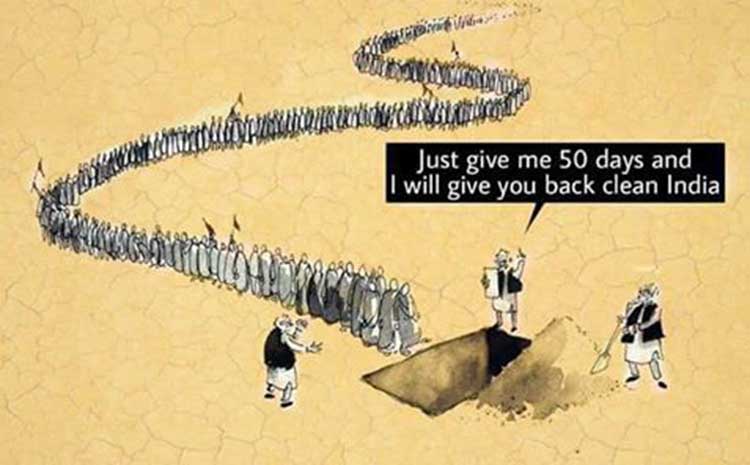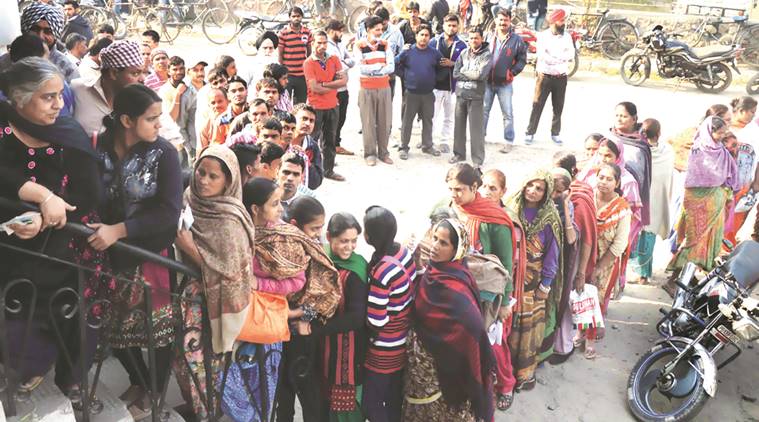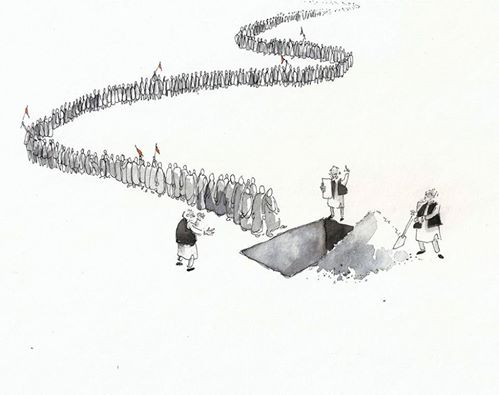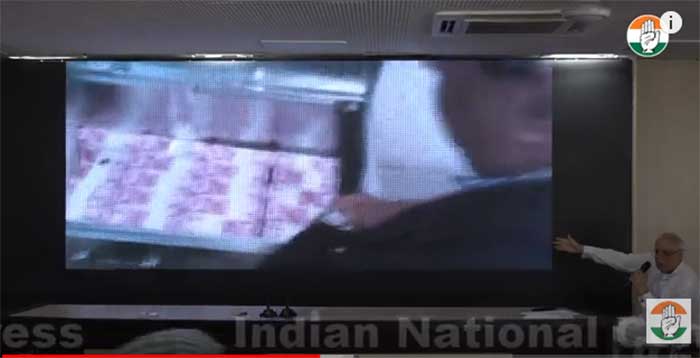
It is early winter and a thick, grimy fog, black and white tinged with grey, hangs over Delhi much of the day. Morning visibility is bad, clears up a bit with a dull sun in the afternoon, before darkness descends again on the city.
A month after Prime Minister Narendra Modi announced his demonetisation policy, the gloomy weather in the national capital describes quite well the mood of the people here. Sullen but not angry, worried but not yet panicked, uneasy about the future but focused for the present on solving daily problems.
And yet somewhere deep down there is a growing feeling that we are witnessing the twilight of the Indian Republic – at least as we have known it for over six decades- a sovereign, federal, democratic nation, which with all its flaws, stumbles along intact. Few fully understand the real implications of 86% of the Indian currency disappearing overnight but there is foreboding it is a sign of many more drastic events to come.
If something as fundamental as money in a system can be so casually overturned what guarantee is there that you or your family will be safe tomorrow? Why should any of India’s various regions and states take orders from Delhi and its upstart Sultan of Sophistry anymore?
With every passing day though the disaster wrought on the economy and lives of ordinary citizens by demonetisation is becoming starkly apparent. Industries, trade, farming operations and daily consumption of essential goods are collapsing due to the lack of sufficient cash to carry out the simplest of transactions.
The queues at the banks are only getting longer and more frustrating with a surge in violent incidents as the initial support for the government’s self-proclaimed ‘war on black money’ wears thin. After all it is not the rich and powerful who are lining up day after day to exchange their old notes or try and withdraw a paltry 2000 Rupees from the few ATMs that work here and there.
In the meanwhile, the elderly and weak die in the wait like only they can, tired and breathless at the heartlessness of it all. How much more suffering is in store and how many needless lives lost to this manmade disaster – nobody really knows.
There is very little talk now from the government of any windfall gains to state revenues due to demonetisation, as almost all the ‘black cash’ around finds its way back into the banking system. There are zero measures to tackle the far larger problem of ‘black wealth’, in the form of gold, property, foreign accounts revealing the fundamentally dubious nature of this ‘war on corruption’.
A desperate regime aids this conversion withmarginally stiffer penalties on unaccounted money coming into the banks,making the current crusade just a continuation of previous voluntary disclosure schemes for tax evaders. Calculations made by respectable research institutions show the costs to the Indian economy of demonetisation will far exceed any benefits it brings.
The rhetoric has instead already turned to the cuckoo world of a ‘cashless economy’, where everyone will live happily tied to a digital grid, run by the government hand in glove with banks, payment gateways, e-commerce companies and other peddlers of seductive software. All you need is a secure identity, the Aadhar card, the number imprinted on which will open or close doors depending on your credit rating. (If Aadhaar cards get fabricated on a large scale- as they are perhaps already- the powers that be will insist on a special stamp with indelible ink on your forehead to certify you are allowed to exist on this planet!)
It would all be very laughable if not for the cruel implications in a country where a majority still struggle to eat, cannot read or write and survive on a daily basis without power or water. It is only a generation ago that the poor learnt to negotiate cash – itself a complicated concept- and here they are being told to abruptly go digital. It is as if the Earth opened up one morning and swallowed them wholesale.
Along with the poor the real target of demonetisation are thousands of small and medium businesses which thrive only on cash transactions and underpin Indian democracy itself through both their sheer diversity and ability to earn and live independent of state support. Once they are decimated it will be that much easier to establish total control over the Indian economy by a handful of large corporate monopolies, which will also facilitate political dictatorship.
Sure, informal enterprises avoid giving tax but then what exactly will the Indian state give them in return if they become compliant – good schools, infrastructure, quality health care, pensions? Why should anyone pay tax to a government that seems to use these revenues to fatten the bank accounts of politicians, bureaucrats and crony capitalists?
The educated, urbanclasses are the only ones cheering Modi on right now as they see in the digital economy a consolidation of their traditional power – after all feudalism was also a ‘cashless’ system – not even a signature was required to get things done. A mere wave of the hand was enough to get orders or even orderlies executed in Ram Rajya. ‘E-Brahmanism’ would be indeed be a more appropriate way to describe a society without any physical cash!
Is it really possible to impose such a ‘Uniform Commercial Code’ on such a vast and heterogenous economy like India without sparking a revolt? Isn’t the Modi regime and the cabal of corporates playing with fire by pushing this ‘Big Bang’ reform?
When former Prime Minister Manmohan Singh described demonetisation as a ‘monumental management failure’ he was essentially warning Modi not to bite more than he can chew. He should know, having been the architect of the original ‘Big Bang’ of liberalisation, privatisation and globalisation over two decades ago. It was the tectonic forces he unleased on the Indian economy and society that gave impetus to Hindutva, helped the BJP rise to power and the phenomenon of Narendra Modi himself – all of which swallowed up the Congress party itself.
Of course there will be blowback and long after India recovers from the dire consequences of Narendra Modi’s monetary adventure, future historians will actually wonder what led a ruler, at the peak of his power, to attempt harakiri in this manner? For, it is not difficult really to see what has happened – the man is falling in front of our eyes on his own sword of hubris – the brash weapon that has humbled many a self-styled emperor before him.
Trying to understand the motives many have dubbed Narendra Modi a new Mohammad bin Tughlaq, the 14th Century ruler of Delhi, whose kingdom collapsed due to foolish experiments with new and poorly minted currency. There is some truth to this of course, as grandiose visions that lack of attention to detail and hasty schemes marred by low quality of implementation have indeed been his hallmark so far.
His harsher critics have compared Modi to the notorious Mir Jafar, who due to greed and ambition shook hands with the wily East India Company only to lose both arm and country.
Modi, an ordinary pracharak who rose to became Prime Minister, a chaiwallah who rubs shoulders with corporate bigwigs, does represent Mir Jafar’s burning quest for power at any cost.
The collective herding of 1.2 billion people into a ‘cashless economy’ is also nothing less than the return of Company Raj with loss of control over lives and livelihood for the Indian people. Mastercard, Visa, Facebook, Google, Paytm are the new Robert Clives of our times, manipulating intrigues in the Nawab’s palace to take over control.
There is even a Jagat Seth around, Mir Jafar’s financier, in the form of none other than Mukesh Ambani, whose business interests are poised to benefit most from the nature and timing of the demonetisation policy. Launching ‘Jio Money’, a payment gateway venture, in the first week of December, Ambani praised demonetisation in the same vein as a weapons dealer extolling the merits of war.
Coming back to Modi and theparallels with Tughlaq and Mir Jafar, they do indicate the way he thinks and behaves but do not fully capture what he is all about. In order to really get a more accurate picture of the man, there are two other essential ingredients that need to be added. One is the persona of a small town hustler of whom our Dear Leader has more than a heavy dose of and which is what lends him colour and explains his widespread popularity.
The dandy man in dark glasses, dressed in a white suit with flower sticking out his pocket, ambushing foreign Heads of State for a hug or posing like a tourist for selfies around ancient monuments – that is what endears him to the masses. All embellished by the legend that he is someone from humble origins who has made it big – something every poor man and woman admires and dreams of.
The other component of his character and one that makes him immensely dangerous though, is that ofamegalomaniac with the mind of a shrewd criminal. Nothing less that a wannabe Godfather. Someone, who is willing to do or say anything to get his way. With no loyalty to anyone except himself and his immediate benefactors – in the current case the corporate backers who financed his climb to power.
This makes him frightening to even those who helped him get where he has reached today – a man untethered to any principle, person or even the political party he leads. Remember Haren Pandya? The only consultation Modi seems to have done before embarking on the drastic experiment of ‘notebandi’ was perhaps in front of a mirror with himself – for it turns out none of the senior leaders of the BJP or even the RSS had a clue as to what he was upto- though all of them are lining up to praise his ‘brilliant’ policy out of fear today.
The reason why Modi is able to ride roughshod over his own party stalwarts is because he has cultivated a financial and popular support outside the traditional base of the organisation. If small and medium traders disappear with the digital economy, so be it – the future belongs to big corporations anyway. If the extreme Hindu right is upset with him how does it really matter when hecan win elections with the support of corporate financed propaganda?
Nothing else – but this understanding of Modi as a mix of Tughlaq, Mir Jafar, petty hustler and gangster –explains the indifference to consequences with which the entire demonetisation exercise was thought up and implemented. Nothing else explains also the arrogance that Modi continues to display about his own abilities as a ‘visionary’ and the complete lack of remorse for the immense hardships he has subjected the Indian population to.
What we have got from the Prime Minister so far in response to criticism or complaint is an anecdote about a beggar somewhere with a swipe card machine. Is this supposed to be the new aspirational model for the country – jobless citizens asking for doles in digital currency?
And of course, that casual ‘Robin Hood’ statement too, urging poorer citizens with Jan Dhan accounts not to return any of the unaccounted cash deposited in their names by those trying to convert their black money into white.
Wow! Did he really mean that? If he did, then good for him! I am just waiting for the day the masses figure out that all ‘white money’ in this country is only so because successive regimes have helped ‘whitewash’ it through convenient laws. When that finally happens – taking cue from Modi’s statement about redistributing wealth – there will not be a single Ambani or Adani shop left anywhere in the country!
It is clear, that even by the gross standards of the Indian elite’s historical disdain for the fate of the nation’s marginalized Narendra Modi’s entire discourse around the impact of his demonetisation policy is obscene beyond belief. In any other country, far less poor than India is, by now there would be class war raging– a French Revolution scenario complete with guillotines and heads rolling on the boulevard around India Gate.
That’s an exaggeration of course, but at least there would be mass protests around the nation calling for resignation of the Modi regime, the sacking of the RBI Governor, for restoration of the old Rs.500 notes and other measures that can relieve the immediate misery caused by demonetisation. Instead, so sorry is the state of our Opposition parties- except for the brave Mamata Banerjee- that instead of hitting the streets all they want is a statement from the Prime Minister in Parliament!
Given the reality that there is no organised opposition to the ruling dispensation outside, a more likely scenario is perhaps a palace coup against Modi from within. There is no doubt, while Modi is trying hide his wounds and bluster his way through the mess he has created, it is only a matter of time before, not just the Indian public, but also his own political party and fans turn on him viciously.
Leading this plot will be the Peshwas who run the RSS – unhappy with Modi getting too big for his boots and anxious to consolidate power before he fritters it away. In that case we may even see the rise of a new, more rigid and rabid version of Modi in the days ahead as his own partymen abandon him and move to the next level of their project to establish Hindu Pad Padshahi in the country.
The sad truth of all this is that if you thought Modi was bad, there are even worse characters lurking in the shadows, just waiting to take over.
Caveat: Narendra Modi is only incidental to the snaring of the Indian Republic by the powerful forces of global finance. He happens to be the right man at the right moment to do their bidding. There is no doubt any future dispensation will come under similar pressure from outside to handover the keys or encrypted passwords to the kingdom’s treasury.
It will take much more than bogus ‘Hindu Nationalism’ of the RSS Peshwas to resist the temptation to sell Indian sovereignty and independence for a few shining sovereigns more. Maybe it is time for those interested in saving the Indian Republic to revisit 1857 for clues as to what needs to done next. No, I am not comparing Mamata Banerjee to the Rani of Jhansi or Kejriwal to Tatya Tope!
Satya Sagar is a journalist and public health worker. He can be reached at [email protected]
















































